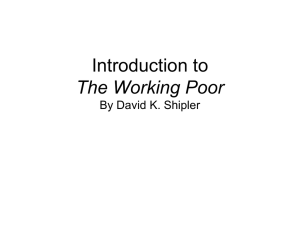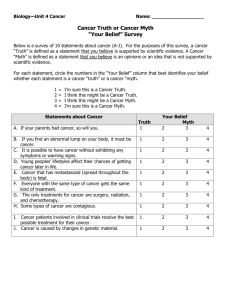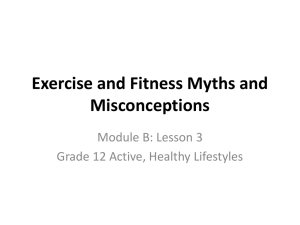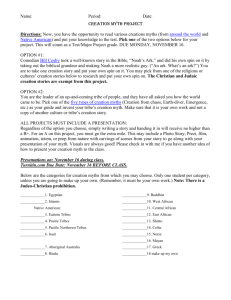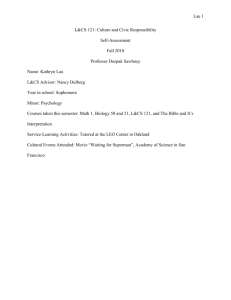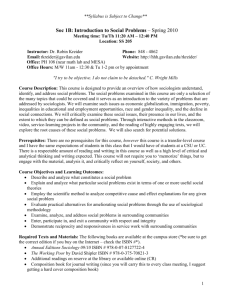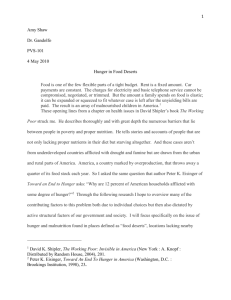L&CS 121: Culture and Civic Responsibility Self
advertisement
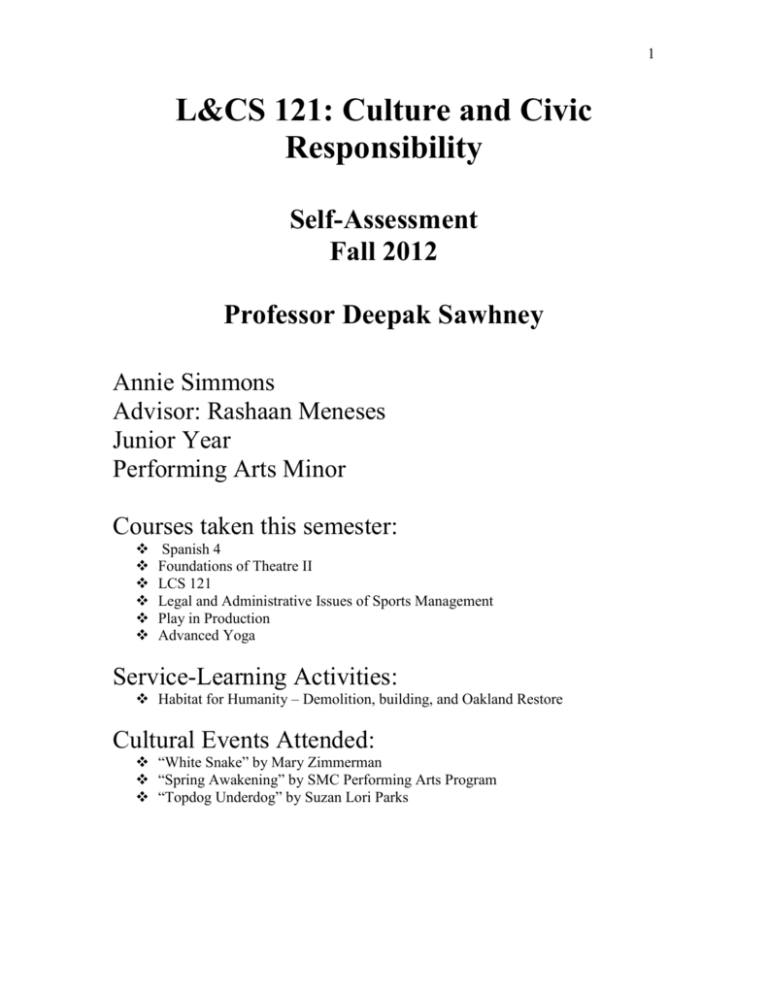
1 L&CS 121: Culture and Civic Responsibility Self-Assessment Fall 2012 Professor Deepak Sawhney Annie Simmons Advisor: Rashaan Meneses Junior Year Performing Arts Minor Courses taken this semester: Spanish 4 Foundations of Theatre II LCS 121 Legal and Administrative Issues of Sports Management Play in Production Advanced Yoga Service-Learning Activities: Habitat for Humanity – Demolition, building, and Oakland Restore Cultural Events Attended: “White Snake” by Mary Zimmerman “Spring Awakening” by SMC Performing Arts Program “Topdog Underdog” by Suzan Lori Parks 2 Unicorns, fairies, and centaurs come to mind when I think of the word myth. Myths are things that are distant from me; they are outlandish and unrealistic ways of freeing the mind from reality. Or are they? This class has introduced me to the fact that Americans have created many realities out of lies or injustices; it has helped me come to terms with the fact that many things that I have simply accepted as the truth are actually myths. I will admit; at the beginning of this course I was naive about the true inner workings of our country. The readings in this class, especially “The Working Poor” by David K. Shipler opened my eyes to many blessings that I have taken for granted in the past. Shipler found the perfect way to describe how that most vital work in our country is really done, thorough a group of people who, when thinking of the ideals and values of America, we typically seem to forget. He calls the workers in the fields that provide us food, the employees building our roads and bridges, and those who ring us up at our local Target “invisible in America”. When describing people who fall in this category, Shipler is talking about all those people in the working class who are stuck, for various reasons, in low paying jobs that are undesirable to many Americans but absolutely necessary to perpetuate our capitalistic system. I have never really taken to the time to examine how much weight these invisible people carry in our society; they are an integral part in my everyday life yet they get treated like they hardly matter with low pay and miserly benefits, if any. This leads me to the first myth that I was confronted with as early as elementary school and believed was the truth until now, the myth of the American Dream. America for the settlers who came over from Europe was a place of hope filled with, “the promise 3 of a land where the rewards of a man’s industry follow with equal steps the progress of his labor” (Rereading America, 255). We have been told too many times: if you work hard enough, you will gain success. In America, success equates to happiness. This, in my opinion, is one of the biggest failures of our American cultural values. Success should not be measured by how much green paper you have in your wallet but by how smiles you can put on other people’s faces. The American Dream perpetuates this capitalistic notion that goods and services are what make us happy. The image of the American Dream is also extremely misleading. It promotes false hopes. Many impoverished people who work extremely hard will never make it across the poverty line no matter how hard they try. We have certain policies in place that specifically suppress millions of poor Americans, the ones who, as a collective whole, are the people we depend upon the most. Our education systems, our tax layouts, and the way that our counties are drawn on our maps are keeping those who are invisible in America as just that, invisible. As long as we keep the poor suppressed, then things will run smoothly… Shipler describes this ugly truth by saying that, “poverty is a peculiar, insidious thing: a cause whose effects then cause the original cause, or an effect whose causes are caused by the effect” (“The Working Poor”, 53). Poverty is a cycle that is almost impossible to break. There is no such thing as individual opportunity if you are born in an impoverished family. Escaping poverty is so difficult because our system makes it that way. Zip codes are much more than just numbers; they determine opportunities and futures. The family that you are born into determines the class that you fall into. This class then defines where you are able to go to school which defines where you will get a job which plays 4 directly into where you will buy a home which leads us to where you will send your kids to school. Moving up in social classes is not as easy as it sounds; there is really no such thing as going from rags to riches. Today, moving up the economic ladder is way more difficult than it was in the past. The wealth gap is ever expanding, bringing more division between the economic classes. One such example of this is our tax system. We have recently discovered that the one percent of our country who holds the vast majority of the wealth (about 65% of the wealth) only pays about thirty five percent of the taxes. This disparity is still something about our capitalist system that doesn’t make sense to me. Why would the people who are struggling to get by, the people who are worried about paying medical bills, paying for college , or even paying for supper that night the ones who have to support the systems that wealthy just take advantage of? Take the American education systems for example. Once again, a lot of the discrepancies between our school systems today come down to economics. The better schools are the schools that are located in the more affluent neighborhoods. The schools that can afford to have small classes and can provide proper seating for their students are the schools that produce the most creative minds. They are also the schools that many minorities cannot afford to attend. Once again, this discrepancy between classes comes into play: “there is a new emboldenment among the relatively privileged to isolate their children as completely as they can from more than token numbers of the children of minorities” (Shame of the Nation, 135). Though Kozol doesn’t go right out and say it, he means that richer white parents only want their kids around other wealthy white kids. This not only teaches children that racism is acceptable but it implies a sort of hierarchy that may affect a child’s view of a different race. Mindsets like these often negatively 5 shape a person’s view on identity, both of self and of the world around them. They promote a mindset that is all about “us” and “them”, a mindet that thrives on pointing our differences. Class difference, a topic that Americans apparently find taboo “affects more than life-style and material well-being. It has a significant impact on our physical and mental well-being as well” (Rereading America, 314). People who are living paycheck to paycheck have to make choices. Which would you choose, to eat or to go to the dentist? To buy the organic milk or to buy the soda that is one dollar for a liter? Which brings us to another myth that is quite disturbing to me: the myth of America as the land of choices. No, America is only the land of choices for those who have the means to choose. In Lafayette, California, if I want to go grab something to make for dinner, all I need to do is hop in my Lexus and drive to one of the three supermarkets that are within five minutes of each other. Oakland has parts, however, that they call a food deserts, or areas where there are no grocery stores. The only place for a hungry consumer to buy food is a gas station or a liquor store. How so many people be denied of the very necessities of life? Why is this allowed to go on? Equal opportunities in America today are about as equal as the Jim Crow laws were in the 1870s. I was shocked and appalled to hear that women make only eighty-two cents for every dollar that a man makes in today’s modern market. What is this saying about our culture? To me, it says that the workforce, created by patriarchal and closed minded men still values the work of males more than the work of females. How, in this day and age, can we still be facing these problems of sexism, racism, and classism? Why do employers value the work that males do more than that of females? 6 Though I still have a lot of questions that are unanswered about why we chose to go on turning a blind eye to a lot of the injustices in our society, this class has inspired me to thoroughly examine things that I have accepted as the truth. It has taught me that there is much to be gained from questioning authority. Most importantly, however, it has taught me that myths are real; the only truth is the truth that I discover for myself, my personal truth.





